Battle of New Orleans
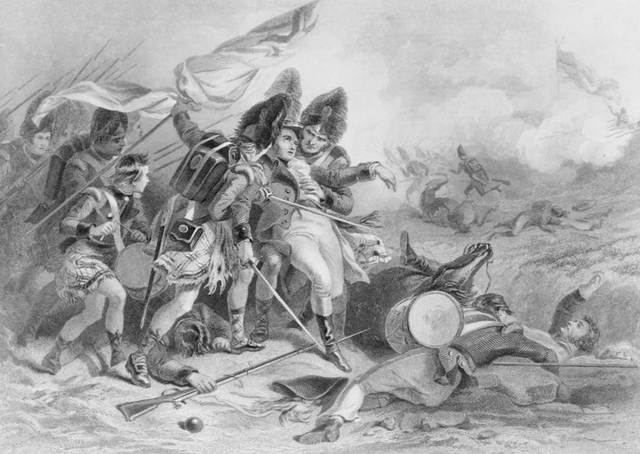
Battle of New Orleans

| Battle of New Orleans | |||||||
|---|---|---|---|---|---|---|---|
| Part of the War of 1812 | |||||||
| |||||||
| Belligerents | |||||||
|
| ||||||
| Commanders and leaders | |||||||
| Strength | |||||||
| ~ 5,700[2] | ~ 8,000[2] | ||||||
| Casualties and losses | |||||||
| 55 dead 185 wounded 93 missing[3]Total: 333[2] | 386 dead 1,521 wounded 552 missing or captured[3]Total: 2,459[2] | ||||||
The Battle of New Orleans was fought on January 8, 1815[1] between the British Army under Major General Sir Edward Pakenham and the United States Army under Brevet Major General Andrew Jackson.[2] It took place approximately 5 miles (8.0 kilometers) east-southeast of the city of New Orleans,[4] close to the town of Chalmette, Louisiana, and it was a U.S. victory.[2]
The battle took place directly after the signing of the Treaty of Ghent on December 24, 1814, before news of the treaty could reach the United States. American troops defeated a poorly executed British assault on New Orleans in slightly more than 30 minutes, despite the British having a large advantage in training, experience, and fielded troops. The Americans suffered roughly 250 casualties, while the British suffered roughly 2,000.
| Battle of New Orleans | |||||||
|---|---|---|---|---|---|---|---|
| Part of the War of 1812 | |||||||
| |||||||
| Belligerents | |||||||
|
| ||||||
| Commanders and leaders | |||||||
| Strength | |||||||
| ~ 5,700[2] | ~ 8,000[2] | ||||||
| Casualties and losses | |||||||
| 55 dead 185 wounded 93 missing[3]Total: 333[2] | 386 dead 1,521 wounded 552 missing or captured[3]Total: 2,459[2] | ||||||
Background
In August 1814, Britain and the United States began diplomatic negotiations to end the War of 1812.[5] However, British Secretary of War Henry Bathurst wrote Pakenham's secret orders of October 24, 1814, commanding him to continue prosecuting the war even if he heard rumors of a peace treaty being signed. Bathurst expressed concern that the United States might not ratify such a treaty, thus continuing the war, and he did not want Pakenham to endanger his troops or miss an opportunity to gain an advantage over the American army.[6]
Prelude
Lake Borgne
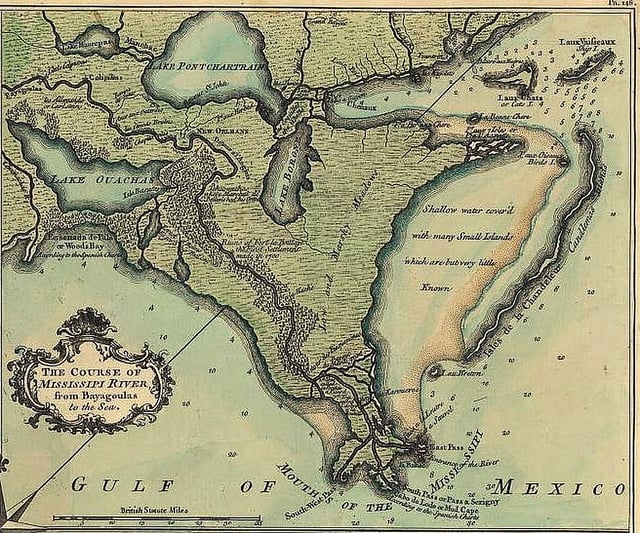
Lake Borgne, Louisiana, 1720.
Sixty British ships had anchored in the Gulf of Mexico to the east of Lake Pontchartrain and Lake Borgne by December 14, 1814 with 14,450 soldiers and sailors aboard under the command of Admiral Sir Alexander Cochrane.[7][8] An American flotilla of five gunboats prevented their access to the lakes, commanded by Lieutenant Thomas ap Catesby Jones. On December 14, around 1,200 British sailors and Royal Marines under Captain Nicholas Lockyer[9] set out to attack Jones' force. Lockyer's men sailed in 42 longboats, each armed with a small carronade. Lockyer captured Jones' vessels in a brief engagement known as the Battle of Lake Borgne. 17 British sailors were killed and 77 wounded,[10] while 6 Americans were killed, 35 wounded, and 86 captured.[10] The wounded included both Jones and Lockyer. Thousands of British soldiers under the command of General John Keane then rowed to Pea Island (possibly now Pearl Island) where they established a garrison, about 30 miles (48 km) east of New Orleans.[11]
Villeré Plantation
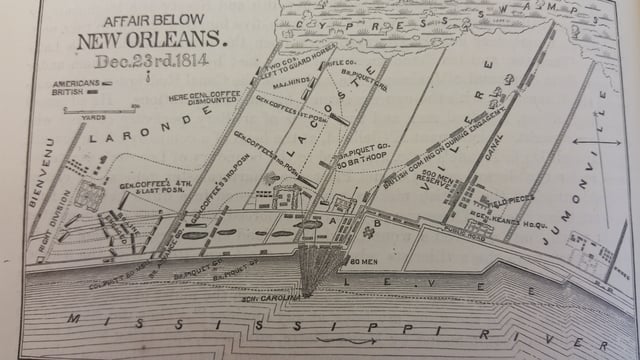
Affair Below New Orleans: December 23, 1814[12]
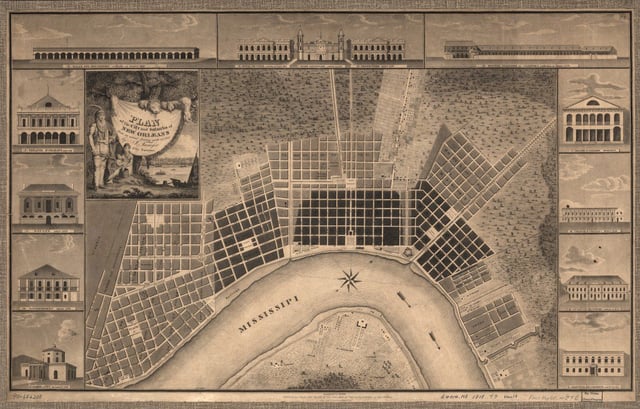
Plan of the city and suburbs of New Orleans from an 1815 survey[19]
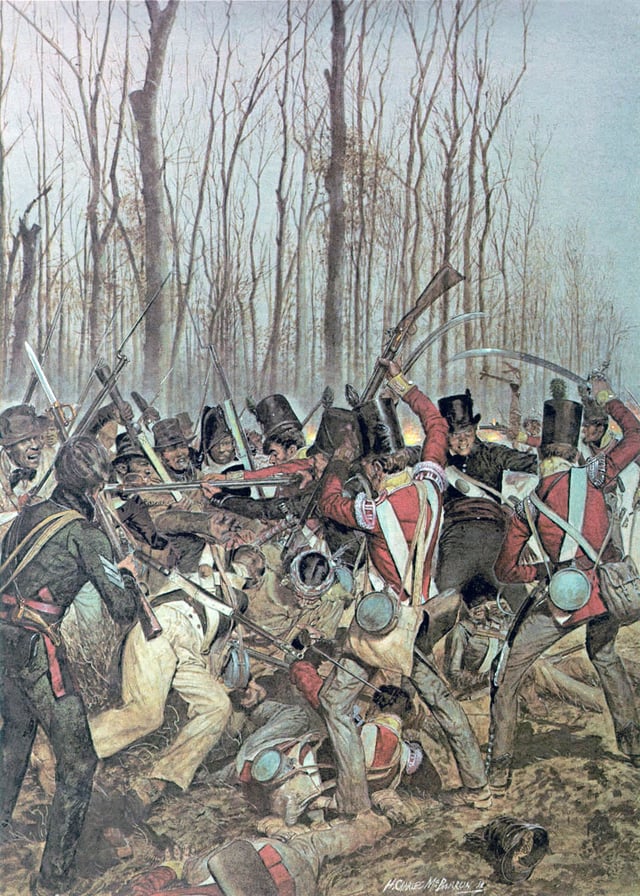
H. Charles McBarron, Free Men of Colour and Choctaw Indian Volunteers at New Orleans, Louisiana (1982)
On the morning of December 23, Keane and a vanguard of 1,800 British soldiers reached the east bank of the Mississippi River, 9 miles (14 km) south of New Orleans.[13] They could have attacked the city by advancing a few hours up the river road, which was undefended all the way to New Orleans, but Keane decided to encamp at Lacoste's Plantation[14] and wait for the arrival of reinforcements.[15] The British invaded the home of Major Gabriel Villeré, but he escaped through a window[16][17] and hastened to warn General Jackson of the approaching army and the position of their encampment.
At the close of Major Villere's narrative the General drew up his figure, bowed with disease and weakness, to its full height, and with an eye of fire and an emphatic blow upon the table with his clenched fist, exclaimed: "By the Eternal, they shall not sleep on our soil!"— Stanley Clisby Arthur, The Story of the Battle of New Orleans[18]
That evening, Jackson led 2,131[20] men in a brief three-pronged assault from the north on the unsuspecting British troops, who were resting in their camp. He then pulled his forces back to the Rodriguez Canal, about 4 miles (6.4 km) south of the city. The Americans suffered 24 killed, 115 wounded, and 74 missing,[21] while the British reported their losses as 46 killed, 167 wounded, and 64 missing.[22]
Historian Robert Quimby argues that the British won a "tactical victory, which enabled them to maintain their position",[23] but they "were disabused of their expectation of an easy conquest".[24] As a consequence, the Americans gained time to transform the canal into a heavily fortified earthwork.[25] On Christmas day, General Edward Pakenham arrived on the battlefield. He ordered a reconnaissance-in-force on December 28 against the earthworks, and he met with General Keane and Admiral Cochrane that evening for an update on the situation. Pakenham wanted to use Chef Menteur Road as the invasion route, but he was overruled by Admiral Cochrane, who insisted that his boats were providing everything needed.[26] Admiral Cochrane believed that the veteran British soldiers would easily destroy Jackson's ramshackle army, and he allegedly said that, if the army did not do it, his sailors would, and the meeting settled the method and place of the attack.[27]
When the British reconnaissance force withdrew, the Americans immediately began constructing earthworks to protect the artillery batteries. These defenses were christened Line Jackson. They installed eight batteries, which included one 32-pound gun, three 24-pounders, one 18-pounder, three 12-pounders, three 6-pounders, and a 6-inch (150 mm) howitzer. Jackson also sent a detachment to the west bank of the Mississippi to man two 24-pounders and two 12-pounders on the grounded warship USS Louisiana. Even so, the British greatly outnumbered the Americans. Jackson's total of 4,732 men was made up of 968 Army regulars,[28] 58 Marines (holding the center of the defensive line), 106 Navy seamen, 1,060 Louisiana militia and volunteers (including 462 blacks), 1,352 Tennessee militia, 986 Kentucky militia, 150 Mississippi militia, and 52 Choctaw warriors, along with a force from pirate Jean Lafitte's Baratarians. Jackson also had the support of the warships in the Mississippi River, including USS Louisiana, USS Carolina, and the steamboat Enterprise. Major Thomas Hinds' Squadron of Light Dragoons, a militia unit from the Mississippi Territory, arrived at the battle on December 22.[29]
The main British army arrived on New Year's day 1815 and began an artillery bombardment of the American earthworks. This began an exchange of artillery fire that continued for three hours. Several of the American guns were silenced, including the 32-pounder, a 24-pounder, and a 12-pounder, while some damage was done to the earthworks. The British artillery finally exhausted its ammunition, and Pakenham canceled the attack. He did not know that his attack had come close to success, as the American defenders on the left of Line Jackson near the swamp had broken under the fire and abandoned their position. Pakenham decided to wait for his entire force of over 8,000 men to assemble before continuing his attack. The British regulars included the 4th, 7th, 21st, 43rd, 44th, 85th, 93rd, a 500-man "demi-battalion" of the 95th Rifles, 14th Light Dragoons, and the 1st and 5th West India Regiments of several hundred free black soldiers recruited from the British West Indies colonies. Other troops included Hitchiti Indians led by Kinache.
Battle
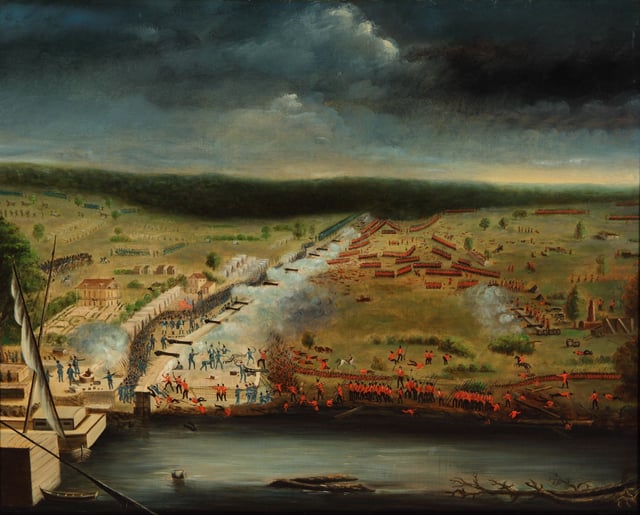
Jean Hyacinthe de Laclotte, Battle of New Orleans (1815)
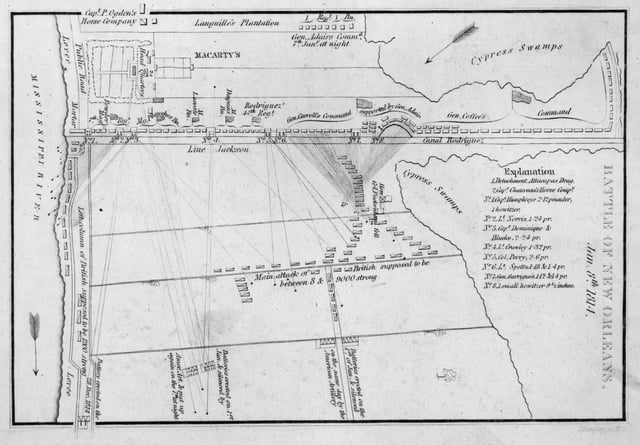
Battle of New Orleans: Jan. 8th

The Battle of New Orleans: Situation on 8 January 1815
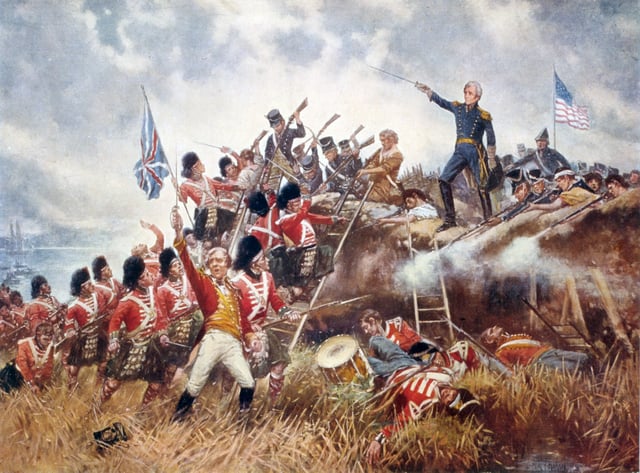
E. Percy Moran, The Battle of New Orleans (1910)

Chalmette Battlefield: The main British attack was aimed just beyond the two farthest cannons at Batteries 5 and 6
The British marched against General Jackson's lines of defense on Sunday, January 8, 1815 at 05:00, the infantry and one rifle unit advancing in two columns under the cover of artillery.[30] The Americans had constructed three lines of defense, the forward one four miles in front of the city. It was strongly entrenched at the Rodriguez Canal, which stretched from a swamp to the river, with a timber, loopholed breastwork and earthworks for artillery.[31] [] [32]
The British battle plan was for an attack against the 20-gun west bank battery, then to turn those guns on the American line to assist the frontal attack.[31] [] In the early morning of January 8, Pakenham gave his final orders for the two-pronged assault. Colonel William Thornton was to cross the Mississippi during the night with his force of 780, move rapidly upriver, storm the battery commanded by Commodore Daniel Patterson on the flank of the main American entrenchments, and then open an enfilading fire on Jackson's line with the captured artillery, directly across from the earthworks manned by the vast majority of American troops[33] Keane was to lead a column along the river, and Major General Samuel Gibbs was to lead a column along the swamp. The brigade commanded by Major General John Lambert was held in reserve.
The British dug a canal to enable 42 small boats to get to the river.[31] [] Preparations for the attack had foundered early on the 8th, as the canal collapsed and the dam failed, leaving the sailors to drag the boats through the mud with Col. Thornton's west bank assault force. This left the force starting off just before daybreak, 12 hours late.[34] The frontal attack was not postponed, however, as the British hoped that the force on the west bank would create a diversion, even if they did not succeed in the assault.[31] []
The main attack began in darkness and a heavy fog, but the fog lifted as the British neared the main enemy line, exposing them to withering artillery fire. Lt-Col. Thomas Mullins, the British commander of the 44th (East Essex) Regiment of Foot, had forgotten the ladders and fascines needed to cross the eight-foot deep and fifteen-foot wide canal.[31] [] and scale the earthworks, and the British forces fell into confusion. Most of the senior officers were killed or wounded, including Major General Samuel Gibbs, who was killed leading the main attack column on the right, and Colonel Rennie, who led a detachment on the left by the river.
The 93rd Highlanders were ordered to leave Keane's assault column advancing along the river, possibly because of Thornton's delay in crossing the river and the artillery fire that might hit them, and to move across the open field to join the main force on the right. Keane fell wounded as he crossed the field with the 93rd. Rennie's men managed to attack and overrun an American advance redoubt next to the river, but they could neither hold the position nor successfully storm the main American line behind it without reinforcements. Within a few minutes, the American 7th Infantry arrived, moved forward, and fired upon the British in the captured redoubt; within half an hour, Rennie and nearly all of his men were dead. In the main attack on the right, the British infantrymen flung themselves to the ground, huddled in the canal, or were mowed down by a combination of musket fire and grapeshot from the Americans. A handful made it to the top of the parapet on the right, but they were killed or captured. The 95th Rifles had advanced in open skirmish order ahead of the main assault force and were concealed in the ditch below the parapet, unable to advance further without support.
The two large main assaults were repulsed. Pakenham and Major General Samuel Gibbs, his second in command, were fatally wounded while on horseback by grapeshot fired from the earthworks. Major Wilkinson of the 21st Regiment reformed his lines and made a third assault. They were able to reach the entrenchments and attempted to scale them. Wilkinson made it to the top before being shot. The Americans were amazed at his bravery and carried him behind the rampart. The British soldiers stood out in the open and were shot apart with grapeshot from Line Jackson, including the 93rd Highlanders, having no orders to advance further or retreat. General Lambert was in the reserve and took command. He gave the order for his reserve to advance and ordered the withdrawal of the army. The reserve was used to cover the retreat of what was left of the British army in the field.
The Chalmette battlefield was the plantation home of Colonel Denis de La Ronde's half-brother Ignace Martin de Lino (1755–1815). The British forces burned it, reputedly causing de Lino's death from a broken heart shortly after returning home three weeks after the battle.[35]
The only British success of the battle was the delayed attack on the west bank of the Mississippi River, where Thornton's brigade of the 85th Regiment and detachments from the Royal Navy and Royal Marines[36][37][38] attacked and overwhelmed the American line.[39] Captain Rowland Money led the Navy detachment, and Brevet Major Thomas Adair led the Marines. Money was captain of HMS Trave, and Adair was the commanding officer of HMS Vengeur's detachment of Marines.[40] The sides of the canal caved in and choked the passage, so that only enough boats got through to carry half of Thornton's force, some 700 men. Thornton did not make allowance for the current, and it carried him about two miles below the intended landing place. His brigade won their battle, but Thornton was badly wounded. This success had no effect on the battle.[41] Army casualties among the 85th Foot were two dead, one captured, and 41 wounded.[39] Royal Navy casualties were two dead, Captain Rowland Money and 18 seamen wounded. Royal Marine casualties were two dead, with three officers, one sergeant, and 12 other ranks wounded. Both Jackson and Commodore Patterson reported that the retreating forces had spiked their cannon, leaving no guns to turn on the Americans' main defense line; Major Mitchell's diary, however, claims that he had "commenced cleaning enemy's guns to form a battery to enfilade their lines on the left bank".[42]
General Lambert ordered his Chief of Artillery Colonel Alexander Dickson to assess the position. Dickson reported back that no fewer than 2,000 men would be needed to hold the position. Lambert issued orders to withdraw after the defeat of their main army on the east bank and retreated, taking a few American prisoners and cannon with them.[39][43] The Americans were so dismayed by the loss of this battery, which would be capable of inflicting much damage on their lines when the attack was renewed, that they were preparing to abandon the town when they received the news that the British were withdrawing.[31] []
The Battle of New Orleans was remarkable both for its brevity and its lopsided casualties, though some numbers are in dispute and contradict the official statistics. Charles Welsh[44] and Zachary Smith [45] echo Adjutant-general Robert Butler's official report to General Jackson which claimed that the British lost 285 killed, 1,265 wounded, and 484 prisoners in 25 minutes, a total loss of 2,084 men; American losses were only 13 killed, 30 wounded, and 19 missing or captured.[46] Around 484 British soldiers had pretended to be dead; they rose up and surrendered to the Americans when the shooting stopped. One bugle boy climbed a tree within 200 yards of the American line and played throughout the battle, with projectiles passing close to him. He was captured after the battle and considered a hero by the Americans.
Almost universal blame was assigned to Colonel Mullins of the 44th Regiment which was detailed to carry fascines and ladders to the front with which to cross the ditch and scale the parapet, as the soldiers fought their way to the American breastwork. The Colonel was charged with deserting his trust and half a mile to the rear when he was needed at the front. Pakenham learned of Mullins' conduct and placed himself at the head of the 44th, endeavoring to lead them to the front with the implements needed to storm the works, when he fell wounded after being hit with grapeshot some 500 yards from the front line. He was hit again while being helped to mount a horse, this time mortally wounded.[31] [] [47]
Aftermath
Fort St. Philip
The British planned to sail up the Mississippi River, but Fort St. Philip stood in the way, protecting New Orleans from an amphibious assault from the Gulf of Mexico via the Mississippi River. British naval forces attacked it on January 9, but the American forces and gunners working from privateer ships fended them off. They withstood ten days of bombardment before the British ships withdrew on January 18, 1815.
Withdrawal of the British
Three days after the battle, General Lambert held a council of war which concluded that capturing New Orleans and continuing the Louisiana campaign would be too costly, despite the news that the battery had been captured on the west bank of the river. He agreed with his officers to withdraw,[31] [] and the British abandoned their camp at Villere's Plantation by January 19.[48][49]
The fleet set sail toward Mobile Bay, Alabama on February 4, 1815 with all of the British troops aboard,[50][51][52] and the army captured Fort Bowyer at the mouth of Mobile Bay on February 12. They were making preparations to attack Mobile the next day when news arrived of the peace treaty. General Jackson had made tentative plans to attack the British at Mobile and continue the war into Spanish Florida on the grounds that the British were using it as a base. Parliament had ratified the treaty, but Congress and the President did not ratify it until mid-February. It did, however, resolve that hostilities should cease, and the British abandoned Fort Bowyer and sailed home to their base in the West Indies.[53] The Battle of New Orleans had no influence on the terms of the Treaty of Ghent, but the defeat there did compel Britain to abide by the treaty.[54]
It would have been problematic, in any case, for the British to continue the war in America because of Napoleon's escape from Elba on February 26, 1815, which ensured that their forces were needed in Europe.[55] The Treaty of Ghent did not specifically mention the vast territory that America had acquired with the Louisiana Purchase; it only required both sides to give back lands which they had taken during the war.[56]
British casualties from December 25, 1814, to January 26, 1815 were 49 killed, 87 wounded, and 4 missing.[57] British casualties for the entire campaign totaled 2,459 with 386 killed, 1,521 wounded, and 552 missing. American casualties for the entire campaign totaled 333 with 55 killed, 185 wounded, and 93 missing.[3] The engagement was small in scale compared to other battles of 1815, such as the Battle of Waterloo, but it was important for the meaning that Americans applied to it, Andrew Jackson in particular.[58] The Americans believed that a vastly powerful British fleet and army had sailed for New Orleans; Jackson thought that 25,000 troops were coming, and most expected the worst. The news of victory, one man recalled, "came upon the country like a clap of thunder in the clear azure vault of the firmament, and traveled with electromagnetic velocity, throughout the confines of the land."[59] The battle boosted Jackson's reputation and helped to propel him to the White House. The Democratic-Republican Party used the great victory to ridicule the Federalist Party as cowards, defeatists, and secessionists. Pamphlets, songs, newspaper editorials, speeches, and entire plays on the battle drove home the point and glorified Jackson's heroic image.[60]
The battle's lopsided casualties were attributed to poor British planning and communication, culminating in costly frontal assaults against a numerous and heavily entrenched enemy. The Duke of Wellington held that Cochrane was largely at fault for the campaign's failure, and that the British attack could have succeeded were it not for the Admiral's shortcomings. He held Pakenham in high regard and commented in his eulogy:
I cannot but regret that he was ever employed on such a service or with such a colleague. The expedition to New Orleans originated with that colleague…. The Americans were prepared with an army in a fortified position which still would have been carried, if the duties of others, that is of the Admiral [Cochrane], had been as well performed as that of he whom we now lament.[61]
Legacy
Miracle at New Orleans
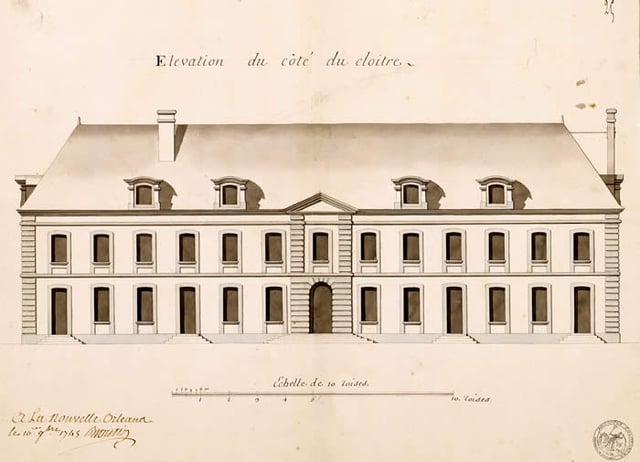
A 1745 elevation of the Old Ursuline Convent, New Orleans by Ignace François Broutin
With the Americans outnumbered, it seemed that the city of New Orleans was in danger of being captured, so the Ursuline nuns and many people of New Orleans gathered in the Ursuline Convent's chapel before the statue of Our Lady of Prompt Succor. They spent the night before the battle praying and crying before the statue, begging for the Virgin Mary's intercession. Rev. William Dubourg offered Mass at the altar on the morning of January 8, and Mother Ste. Marie Olivier de Vezin, prioress of the abbey, vowed to have a Mass of Thanksgiving sung annually should the American forces win. A courier ran into the chapel during communion to inform them that the British had been defeated. General Jackson went to the convent himself to thank the nuns for their prayers. "By the blessing of heaven, directing the valor of the troops under my command, one of the most brilliant victories in the annals of war was obtained."[62] The vow made by Mother Ste. Marie has been faithfully kept throughout the years.[63]
Distinguished service as mentioned in dispatches
In his general orders of January 21, General Jackson, in thanking the troops, paid special tributes to the Louisiana organizations, and made particular mention of Capts. Dominique and Belluche, and the Lafitte brothers, all of the Barataria privateers; of General Garrique de Flanjac, a State Senator, and brigadier of militia, who served as a volunteer; of Majors Plauche, St. Geme. Lacoste, D'Aquin, Captain Savary, Colonel De la Ronde, General Humbert, Don Juan de Araya, the Mexican Field-Marshal; Major-General Villere and General Morgan, the Engineers Latour and Blanchard; the Attakapas dragoons, Captain Dubuclay; the cavalry from the Felicianas and the Mississippi territory. General Labattut had command of the town, of which Nicolas Girod was then the mayor.— William Head Coleman, Historical sketch book and guide to New Orleans and environs[64]
Among those who most distinguished themselves during this brief but memorable campaign, were, next to the Commander-in-chief, Generals Villere, Carroll, Coffee, Ganigues, Flanjac, Colonel Delaronde, Commodore Patterson, Majors Lacoste, Planche, Hinds, Captain Saint Gerne, Lieutenants Jones, Parker, Marent, and Dominique; Colonel Savary, a man of colour nor must we omit to mention Lafitte, pirate though he was.— E. Bunner, History of Louisiana[17]
Over the course of several days, the logistically and numerically superior British force was repelled, in no small part to a small contingent of Marines led by Maj. Daniel Carmick and Lt. Francis de Bellevue of the New Orleans Navy Yard.— 26th Marine Expeditionary Unit A Certain Force in an Uncertain World[65]
At the Battle of New Orleans, [Governor Claiborne's aide-de-camp] Marigny distinguished himself by his courage and activity. It is noteworthy that the glorious victory was reaped on the fields of the plantation of his Uncle de Lino de Chalmette.— Grace King, Old Families of New Orleans[66]
The anniversary of the battle was celebrated as an American holiday for many years called "The Eighth".[67]
Memorials
The Louisiana Historical Association dedicated its Memorial Hall facility to Jackson on January 8, 1891, the 76th anniversary of the Battle of New Orleans.[68]
The Federal government established a national historical park in 1907 to preserve the Chalmette Battlefield. It features a monument and is part of the Jean Lafitte National Historical Park and Preserve.
A five-cent stamp in 1965 commemorated the sesquicentennial of the Battle of New Orleans and 150 years of peace with Britain. The bicentennial was celebrated in 2015 with a Forever stamp depicting United States troops firing on British soldiers along Jackson's Line.
In popular culture
The Buccaneer was a 1938 American adventure film produced and directed by Cecil B. De Mille based on Jean Lafitte and the Battle of New Orleans. It was remade in 1958.
Jimmy Driftwood wrote the song "The Battle of New Orleans" using the melody from "The Eighth of January". It was a 1959 hit for both Johnny Horton (U.S. Number 1) and Lonnie Donegan (U.K. Number 2). The Horton version won the 1960 Grammy Award for Best Country & Western Recording.
See also
List of War of 1812 battles
Further reading
"Battle of New Orleans" [139] . Living Louisiana. Cox. February 20, 2010. Retrieved July 8, 2018 – via YouTube.
"The Battle of New Orleans: 197th Anniversary – January 6-8, 2012 – Chalmette, La" [140] . Louisiana Hometown Network. December 19, 2011. Retrieved July 8, 2018 – via YouTube.
"The Battle of New Orleans" [141] . Louisiana State Exhibit Museum. Retrieved July 8, 2018.
"The Battle of New Orleans – Popular Myths and Legends; And a Few Others Thrown in as well!" [142] . 93rd Sutherland Highland Regiment of Foot Living History Unit. Retrieved July 7, 2018.
Bradshaw, Jim (July 28, 2011). "Battle of New Orleans" [143] . In Johnson, David (ed.). Encyclopedia of Louisiana. New Orleans, Louisiana: Louisiana Endowment for the Humanities. Retrieved July 7, 2018.
"Documents, Artifacts, and Imagery: Instructions to Major-General Sir Edward Pakenham for the New Orleans Campaign" [144] . War of 1812 Magazine. No. 16. The Napoleon Series. September 2011. Retrieved July 7, 2018.
Gayarré, Charles (1867). "Chapter X: 1814‑1815" [145] . History of Louisiana. New York: William J. Widdleton. pp. 441–510.
Kendall, John (1922). "Chapter VI: The Battle of New Orleans" [146] . History of New Orleans. Chicago and New York: The Lewis Publishing Company. pp. 91–109.
King, Grace (1926). "Chapter XI: The Glorious Eighth of January" [147] . New Orleans: The Place and the People. New York: The Macmillan Company. pp. 211–251.
Latour, Major A. Lacarriere (1912). "Historical Memoir of the War in West Florida and Louisiana in 1814-15" [148] . Louisiana Historical Quarterly. Louisiana Historical Society. pp. 143–153.
Roosevelt, Theodore (1912). "The Battle of New Orleans" [149] . In Halsey, Francis W. (ed.). Great Epochs in American History: Described by Famous Writers from Columbus to Roosevelt. New York and London: Funk & Wagnalls Company. pp. 102–112. OCLC 599099 [150] .
Williams, Walter (May 17, 2012). "The Battle of New Orleans" [151] . Dreamsite Productions. Retrieved July 8, 2018 – via YouTube.
Zimmerman, Thomas (2009). "The Battle of New Orleans, December 1814 – January 8, 1815" [152] . BattleofNewOrleans.org. Retrieved July 8, 2018.



